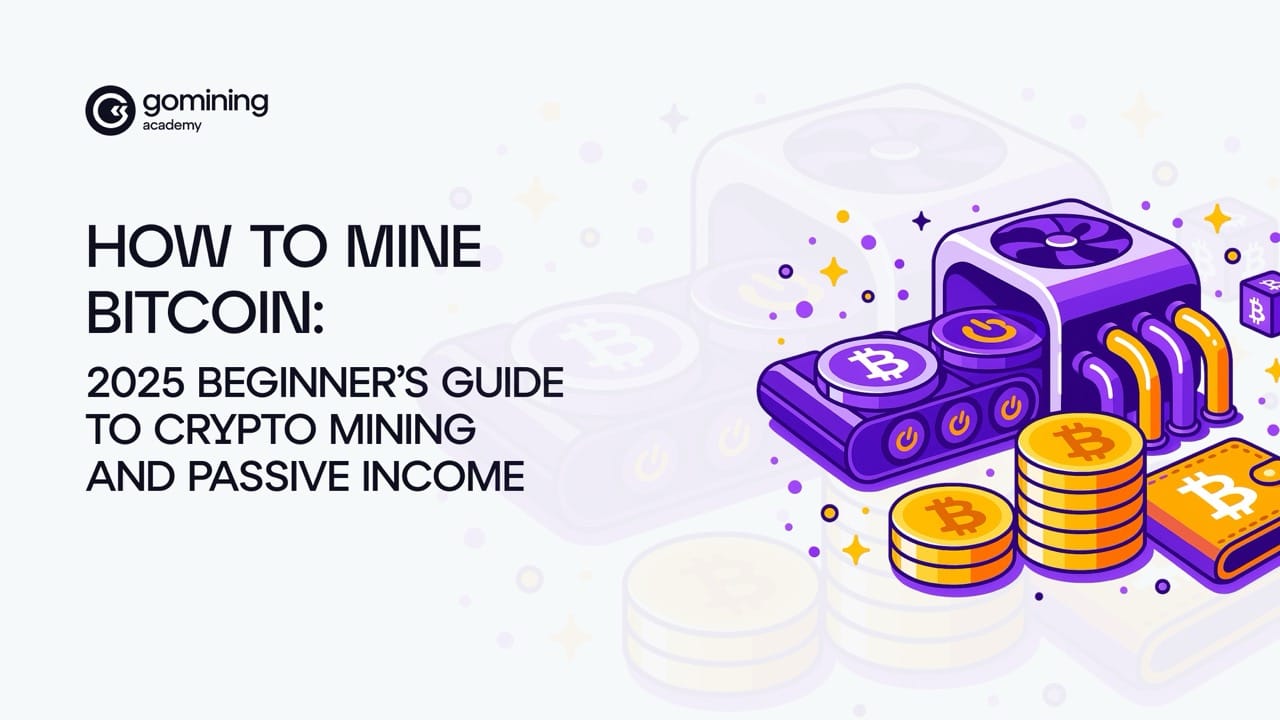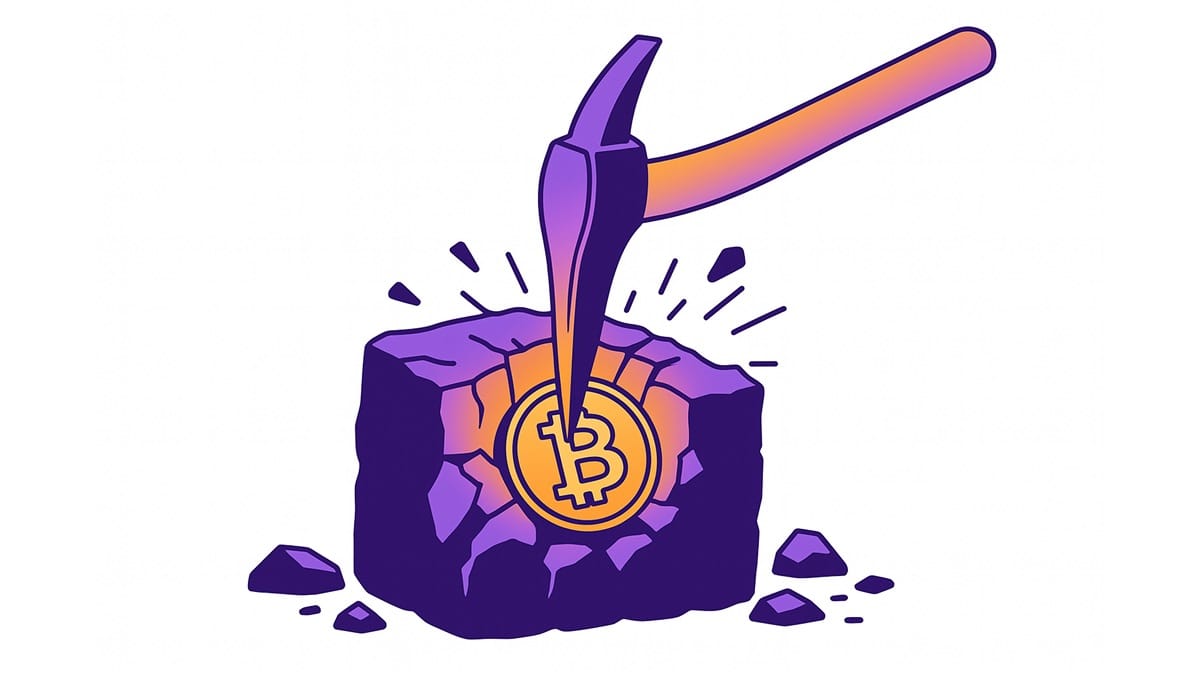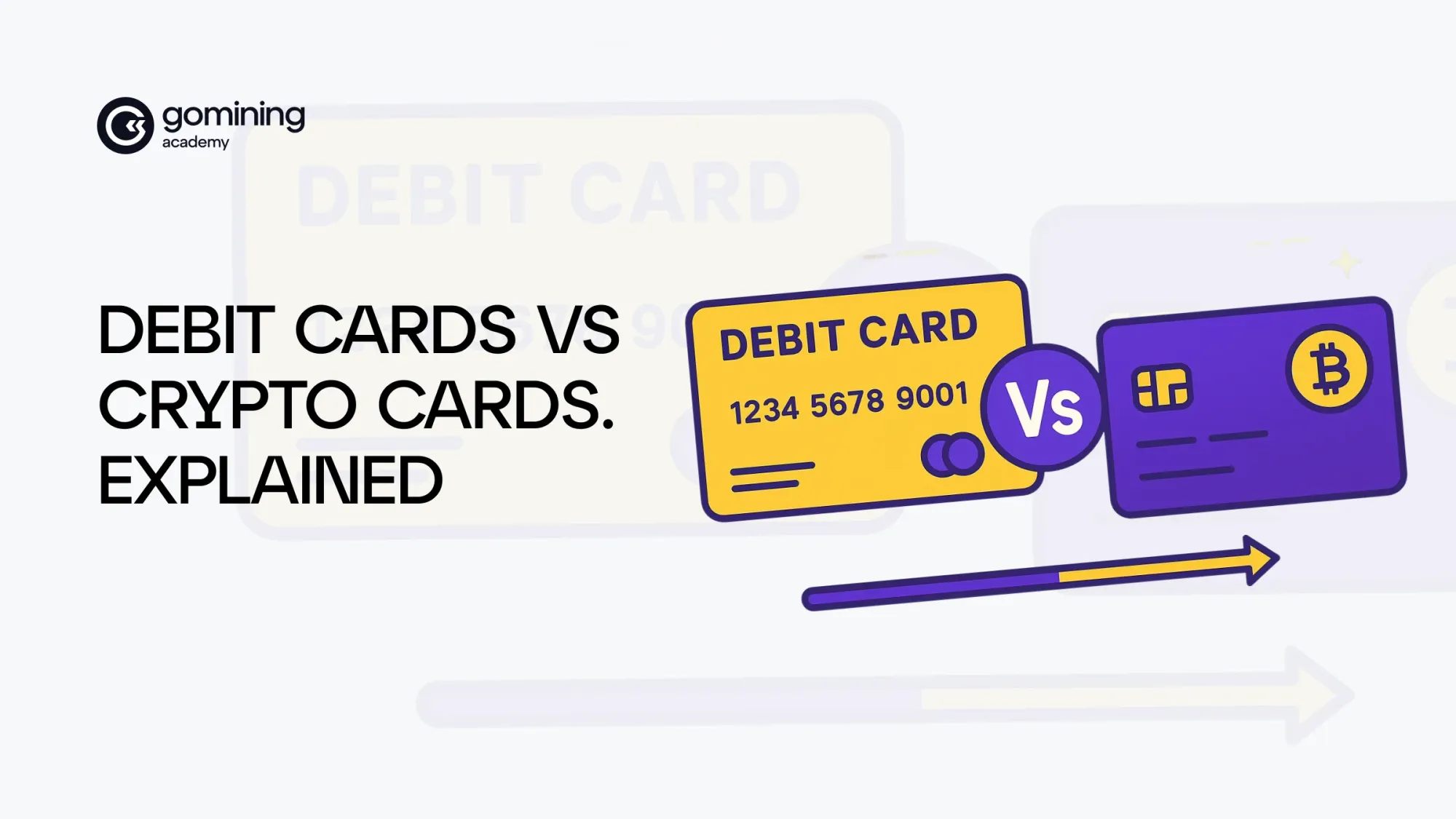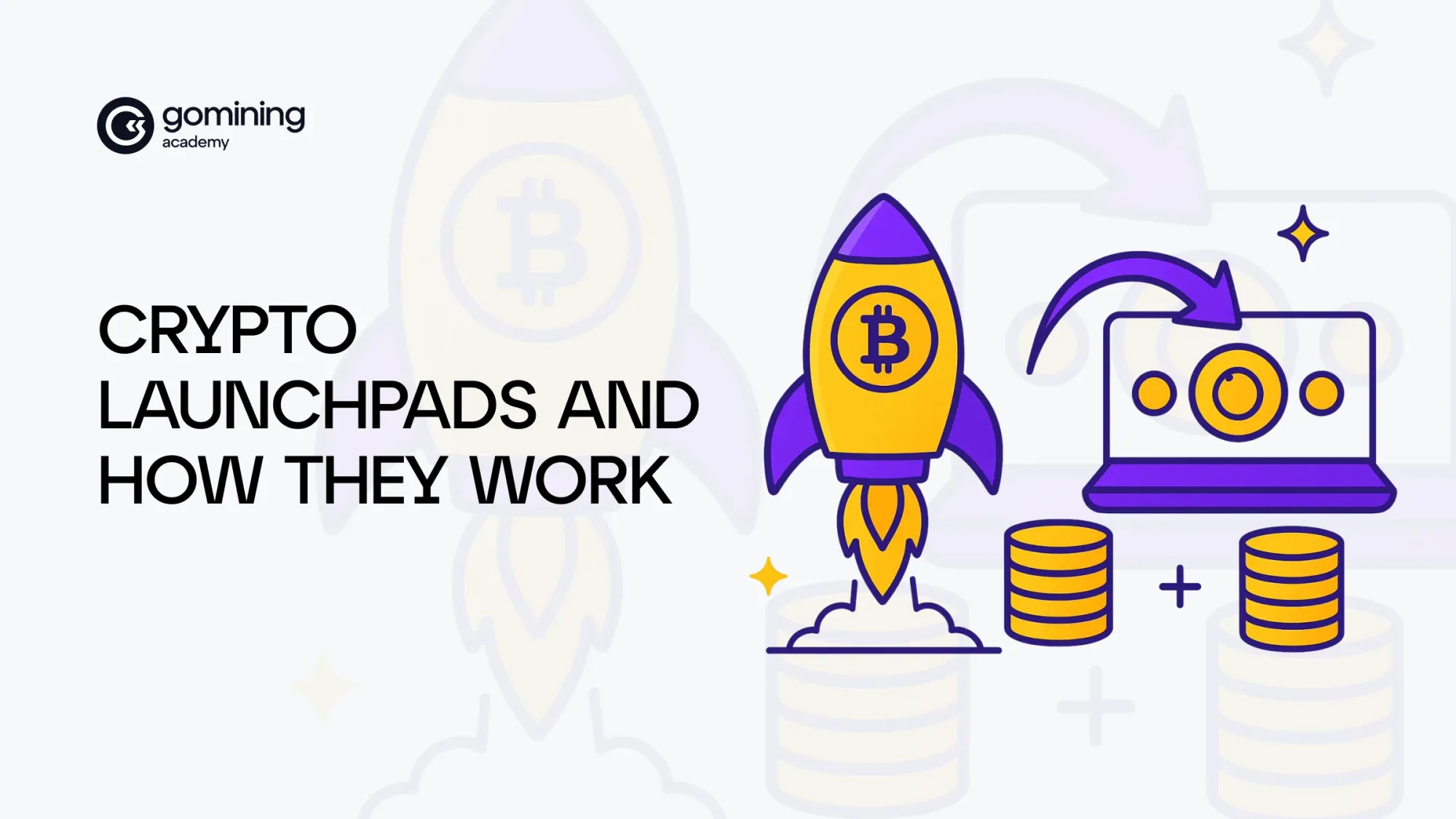How to Mine Bitcoin: 2025 Beginner’s Guide to Crypto Mining and Passive Income

What is crypto mining, in plain English?
Think of it as using computer power to lock new pages into a public ledger and getting paid in digital coins for the effort.
If that sounds intriguing, the next logical question is "How do you mine cryptocurrency today?" and, more specifically, "How do you mine crypto without sinking a fortune into noisy hardware?"
The sections that follow walk you through every option on how to mine Bitcoin—from plugging in a single ASIC at home to renting hash-power online—so you can pick the method that matches your budget, tech skills, and patience level.
Some people are long-term investors and don’t even think of mining Bitcoin as a paycheck—they just want to slowly stack sats (Bitcoin) over time. It’s less about “monthly income,” and more about building a digital piggy bank.
Crypto investments are increasing in popularity. Already, Bitcoin is starting to take on the role of a strategic reserve asset, with some sovereign states treating it much like gold, as a store of value, and are stashing their own strategic Bitcoin reserve. This shift could have huge implications for Bitcoin’s future value and the incentives to keep mining.
Whether you're a tech tinkerer, an investor chasing passive income, or a total beginner asking 'How do I mine Bitcoin?', this step-by-step guide will walk you through everything you need to know.
We’ll cover both how to mine Bitcoin with physical hardware and with digital or cloud solutions, and how to choose the smartest path for your budget and skill level.
If you’re ready to move past the myths and learn how to mine Bitcoin the right way in 2025, let’s dig in.
Table of Contents:
- Can You Still Mine Bitcoin?
- What is Mining Crypto?
- The One-Two Punch: Why Mining is So Difficult Today (Halving & Difficulty)
- Choosing Your Mining Path: Hardware vs. Digital
- Path 1: Hardware Mining (Going DIY)
- Path 2: Digital/Cloud Mining (Tech Trauma-Free)
- Choosing Your Mining Strategy: Solo vs. Pool Mining
- Pool Mining: Team Up, Cash In
- How to Solo Mine Bitcoin: Lone Wolf Mode
- Choosing the Right Strategy: Steady Streams or Jackpot Dreams?
- Can You Still Mine Bitcoin And Make a Profit?
- Conclusion: Starting Your Mining Journey
Can You Still Mine Bitcoin?
Is it still worth mining Bitcoin in 2025, or is the digital gold rush really over?
Once upon a time, you could mine Bitcoin with a laptop and a dream. Fast forward to 2025, and it’s a whole different game.
The idea of passive income through mining still sparkles—earning crypto while you sleep sounds amazing, right? But before you imagine your dusty old PC printing digital gold in the background, it’s time for a reality check.
Yes, you can still mine Bitcoin—but it’s no longer a casual side hustle. If you want to know how to mine Bitcoin today, you’ll need to understand the big changes in the industry. Today’s mining scene is more like a high-stakes arena dominated by industrial-scale operations, ultra-efficient machines, and razor-thin profit margins. If you’re wondering whether it’s still worth jumping in, this guide explains not only whether you can still mine Bitcoin, but exactly how to mine Bitcoin in this new era.
What’s a Bitcoin Miner?
Imagine a giant digital notebook that anyone can read but no one can erase—that’s the blockchain. It’s where all Bitcoin transactions are recorded forever, page by page. And guess who keeps adding those pages? Bitcoin miners. If you want to understand how to mine Bitcoin, you first need to know what a Bitcoin miner does.
A Bitcoin miner is the person responsible for handling the Bitcoin mining machines—usually called rigs. Rigs are specialized computers (often powerful ASICs) built solely for one purpose: racing to solve complex mathematical puzzles that keep the Bitcoin network secure and running. This is how new Bitcoins are created and how every transaction gets verified.
What is Mining Crypto and How Do You Get a Bitcoin?
At its core, mining crypto (or cryptocurrency mining) is the process by which new digital coins are created and transactions are securely verified on a blockchain. But what does that actually mean in practice?
Let’s break it down: Imagine a global competition where thousands of powerful computers—known as mining rigs—are all working around the clock to solve a massive cryptographic puzzle. This process, called proof-of-work, is the backbone of many cryptocurrencies, including Bitcoin.
To add a new block to the Bitcoin blockchain, miners must race to find a special number called a nonce. The only way to discover this number is to make billions (sometimes trillions) of rapid guesses per second. It’s like a worldwide math tournament, where each participant is hoping to be the first to “crack the code.” The first miner to find the right answer gets the privilege of adding the new block to the blockchain and is rewarded with newly minted Bitcoins—a process known as mining cryptocurrency.
Mining crypto isn’t just about earning rewards. It’s also how the entire network stays secure. Every time a miner adds a block, they’re also confirming and locking in all the transactions within that block, making it nearly impossible for anyone to cheat or alter the records.
In summary, mining crypto is the engine that keeps digital currencies like Bitcoin running—rewarding miners for their work, verifying transactions, and maintaining the integrity of the blockchain. Whether you’re curious about how to mine cryptocurrency, or simply want to understand what’s happening behind the scenes, mining is at the heart of the crypto revolution.
How Hard Is It To Mine Bitcoins
This section is crucial for those exploring how to mine Bitcoin efficiently and profitably. Bitcoin has a built-in rhythm, and every 210,000 blocks—roughly every four years—it goes through a halving. That’s when the reward for mining a block gets sliced in half. Back in 2009, miners earned 50 BTC per block. Fast forward through a few halvings, and as of 2024, that reward is just 3.125 BTC. The goal? Slow down the creation of new coins and keep Bitcoin scarce, like digital gold.
Now, pair that with another protocol feature: the mining difficulty. Every two weeks (or every 2,016 blocks), Bitcoin automatically tweaks how hard it is to mine a block. If blocks are being found too quickly, it ramps up the difficulty, meaning a miner must make more guesses. Too slow? It eases off – less guesses. This helps keep the pace steady—one block every 10 minutes. Even if a halving throws a wrench into the works, the network adapts. It’s like cruise control for the Bitcoin network.

This results in a double blow that hits miners hard: first, Bitcoin’s block reward gets halved every four years, slashing your earnings; then, the network dials up the mining difficulty to keep things on schedule of ten minutes per block. You’re earning less and working more—welcome to the 2025 crypto grind. Only the most efficient rigs and cheapest electricity stand a chance in this high-stakes hash race.
How to Harvest Bitcoins: Hardware vs. Digital
So now that you know why mining isn't as easy as it used to be, the real question is: how do you want to play the game? One of the first decisions when you’re figuring out how to mine Bitcoin is whether to—gear up DIY-style, or go digital and let someone else do the heavy lifting. Some people research how to mine Bitcoin with traditional hardware, while others jump into cloud mining for a hands-off approach
- Hardware Mining
That’s like dropping serious cash on a full-blown hi-fi system—towering speakers, amps, cables, the whole setup—just to hear your favorite tunes. It’s powerful, sure, but it’s pricey, high-maintenance, and eats up space. Buying and running your own crypto mining equipment is no different—an intense (and expensive) first step. - Digital/Cloud Mining
Digital and cloud mining are the Spotify of Bitcoin—no gear, no tech headaches, just smooth earning. Platforms like GoMining make it even simpler: you get mining rewards without ever touching a machine. Just pick your digital miner, kick back, and let the passive income roll in.
🖥️ Path 1: Hardware Mining (Going DIY)
So, you’ve decided to get your hands dirty and mine Bitcoin the old-school way—with your own hardware. If you want to learn how to mine Bitcoin at home, you’ll need to invest in specialized hardware.Respect. This is the DIY route where you control everything, from the machine humming in your corner to the satoshis flowing into your wallet. But be warned: it’s not plug-and-play. It’s more like plug, configure, optimize, cool, monitor... and maybe scream into the void a little when your power bill arrives. This section covers how to mine Bitcoin with an ASIC rig and what setup steps you’ll need to follow.
How to Bitcoin Mine – Getting Started
First off, forget laptops and gaming PCs. In 2025, you’ll need an ASIC miner—that’s short for Application-Specific Integrated Circuit. These bad boys are custom-built to do one thing and one thing only: mining Bitcoin at lightning speed. They're loud, hot, and hungry for power, but they’re also your best shot at competing with today’s industrial-scale mining farms.
Look for ASICs with:
- High hash rate (measured in TH/s): This tells you how fast the machine can guess the winning cryptographic puzzle.
- Good efficiency (watts per TH): The lower the energy per hash, the more profit you keep instead of burning it on your electric bill.
- Durability & support: You'll want a miner that can run 24/7 without hiccups—and ideally one with a solid warranty or active community support.
The Setup: Not for the Faint of Heart
Once you’ve got your hardware, you’ll need to:
- Set up power and cooling. ASICs can consume over 3,000 watts and get hot enough to toast marshmallows.
- Install mining software. This connects your hardware to a pool or mining node. Popular options include CGMiner, BFGMiner, or the software recommended by your ASIC manufacturer.
- Join a mining pool (strongly recommended). Solo mining is a gamble. Pools let you contribute your hashpower to a group effort and earn consistent, smaller payouts.
Is It Worth It?
That depends. If your electricity is cheap and you’re good with tech, hardware mining can be a fun side hustle or long-term investment. But keep expectations realistic—it’s not a magical money printer. It’s a grind. You’ll need to monitor your rig’s performance, keep it cool, and be prepared for the market’s ups and downs. If Bitcoin’s price drops or difficulty spikes, your margins shrink.
Still, for many crypto-curious folks, setting up a miner is a hands-on way to learn how to mine cryptocurrency and stay connected to the heartbeat of the blockchain.
Path 2: Digital/Cloud (Tech Trauma-Free)
So, maybe you’re not into the idea of a jet-engine-sounding ASIC rattling in your closet 24/7? You're not alone. So if you're asking, “how can I mine Bitcoin without the tech headache?” this is your lane. Whether you’re a total beginner or just don’t want to mess with hardware, digital/cloud mining offers an easy on-ramp into the world of crypto rewards. Many platforms now make it easy for beginners to discover how to mine Bitcoin with just a few clicks, thanks to digital mining solutions.
What is Digital Mining?
Digital mining is the sleek, modern alternative. It’s like owning part of a mining empire, but without ever plugging in a single cable or touching a fan. For those who want Bitcoin rewards without the tech trauma, this is one of the smoothest on-ramps around.
Instead of buying and managing physical machines, you purchase digital mining power, often in the form of a token or NFT. In this setup, a token or NFT acts like your digital mining badge—it proves you own a slice of a real mining rig, and the blockchain keeps that proof visible, tamper-proof, and impossible to fake.
And What About Cloud Mining?
Cloud mining is slightly older-school but works similarly. You rent hash power from a mining company for a set period, usually via a contract. They handle the hardware and maintenance, and you get the mining rewards (minus their cut). It’s more hands-off than digital mining but also riskier—some cloud mining platforms have a sketchy history. Choose providers with transparency, solid reviews, and real uptime stats.
Pros:
- No Hardware Hassles: No setup, no fans, no cooling systems. Just log in and track your earnings.
- Beginner-Friendly: Perfect for crypto-curious folks who want to dip their toes into mining cryptocurrency without diving into wires and wattage.
- Scalable: Want more mining power? Just buy more hash rate or additional digital miners.
- Truly Passive Income: Once you're set up, you can earn BTC daily—while you sleep, scroll, or sip your coffee.
Cons:
- Less Control: You’re trusting a third party to actually do the mining and share the rewards fairly.
- Fees & Terms: Contracts or platform fees can eat into your profits. Read the fine print.
- Scam Risk (for cloud mining): If it sounds too good to be true, it probably is. Stick with reputable platforms and verified providers.
How to Start Bitcoin Mining : Solo vs. Pool Mining
Deciding how to mine Bitcoin—solo or as part of a pool—affects your payout frequency and your risk. Every miner is racing to solve the next block, and only one winner gets the prize. With the odds growing tougher and profits tighter, miners have had to get creative about how they play the game. That’s where your mining strategy comes in. Understanding the pros and cons of each is key to choosing how to mine Bitcoin most effectively. Time to ask: are you the lone wolf type, or do you like to run with a pack? Do you go it alone or team up for better chances? Let’s break down both options—pool mining, where teamwork brings steady rewards, and solo mining, the high-risk, high-reward route for those chasing the full prize. Which one fits your mining style? Let’s find out.
🤝 Pool Mining: Team Up, Cash In
Think of pool mining like entering a global lottery—but with cryptographic puzzles instead of scratch cards. Pool mining is where thousands of miners unite their computing power to chase rewards together. When the pool cracks a block, the Bitcoin prize is split among everyone based on how much hashpower they contributed.
Analogy: You won’t walk away with the full jackpot, but your odds of actually winning something skyrocket. It’s the smart choice if you prefer a regular drip over a rare deluge.
Choosing a Reputable Bitcoin Mining Pool:
This is a crucial step, as the pool dictates your payout consistency and fees. Consider the following factors:
- Reputation and History: Look for pools with a long track record and positive reviews from other miners.
- User Interface and Support: A user-friendly dashboard and responsive customer support can make a big difference.
- Fee Structure: Most pools charge a percentage of your earnings (typically 1-3%). Understand their fees.
- Minimum Payout Threshold: Check how much Bitcoin you need to accumulate before the pool pays out to your wallet.
How to Mine Bitcoin Solo
Solo mining is the high-risk, high-reward route. You go it alone, with your own rig and no help. If you find a block, you keep the entire reward. No sharing. No fees. Just pure, unfiltered Bitcoin glory. But here’s the catch: your chances of finding a block on your own are microscopic unless you’ve got a seriously beefed-up operation.
Analogy: Solo mining is like buying your own lottery ticket every 10 minutes, hoping to hit the jackpot. Win? You’re rich. But most of the time, it’s just you and your miner staring into the digital void.
🧠 Choosing the Right Strategy: Steady Streams or Jackpot Dreams?
Your mining strategy depends on your resources, patience, and appetite for risk.
- Pool Mining is perfect if you’re just getting started or running a modest rig. It offers predictable income and a smoother entry point.
- Solo Mining is for the bold, the well-equipped, and the slightly masochistic. It’s all or nothing, and that’s exactly how some miners like it.
How long does it take to mine 1 Bitcoin?
If you’ve ever asked how long does it take to mine 1 Bitcoin, you’re not alone. The honest answer is: it depends on three major factors:
- Your hash rate (how much computing power you contribute)
- Current network difficulty (how hard the cryptographic puzzles are)
- Whether you’re solo or pool mining
For a small home rig hashing at, say, 100 TH/s, it could take more than a decade to mine one whole BTC on your own. Even if you bump up to an industrial-scale setup, you’re usually talking months rather than days. That’s why most beginners focus on how to mine crypto via smaller units—earning fractions of a Bitcoin daily—and gradually stacking sats over time.
In pool mining, your effective share of the network’s total hashpower speeds things up dramatically. Still, if you wonder how long does it take to mine one Bitcoin as a pool member, you might expect anywhere from 6–12 months of consistent contributions before you net a full BTC (depending on your share size).
Ultimately, if you’re really keen to know how long to mine one Bitcoin with your specific rig, plug your numbers into a reputable mining profitability calculator. It’ll factor in your hash rate, power cost, and the latest difficulty to give you a personalized timeline.
Digital Mining: Plug-and-Play Bitcoin
But if all that hardware talk sounds exhausting, there’s a much sleeker route such as picking one of the many digital mining solutions out there. With platforms like GoMining, you can buy a piece of real mining power—think of it as renting a robot that does all the hard work for you. Just pick your miner from GoMining’s digital miner collections and explore unique options of GoMining digital avatars.
You easily estimate your returns using their crypto mining calculator. Once you’ve invested, you’ll start receiving daily Bitcoin payouts—no cables, no noise, no hassle.
GoMining’s transparent crypto tokenomics and GOMINING digital token make it easy to track your rewards, while their Bitcoin mining app keeps everything at your fingertips. Want to add a little excitement to your mining? Try boosting your rewards in on the platform’s own Bitcoin mining game, their GameFi-powered mining competition. Still deciding if digital mining is right for you? Check out this in-depth comparison of digital miner vs. cloud mining to find the best fit for your crypto journey.
Can You Still Mine Bitcoin And Make a Profit?
Great question—and the answer is: Maybe, but don’t quit your day job just yet. The real question isn’t just if you can mine Bitcoin, but which mining choice will actually pay off in 2025. Think of Bitcoin mining like planting a money tree… in rocky soil… during unpredictable weather. Yes, it might bear fruit—but not fast, and definitely not without effort.
- Hardware mining: You’ll shell out upfront for gear (like those fancy ASIC miners) and keep paying the electric bill while your machine hums away. Even top-tier rigs often take a couple of years to break even—assuming Bitcoin’s price holds steady and difficulty doesn’t spike.
- Pool mining: By sharing hashpower, you earn smaller, steadier payouts. Your break-even time shrinks to months instead of years, but you give up a slice of each block reward to pool fees.
- Digital mining: No rigs, no noise, no cables. Platforms let you rent or buy mining power—so you skip the hardware headache and get straight to daily Bitcoin payouts. Fees and returns vary, but digital mining can be the lowest-effort way to stack sats alongside your hardware or pool strategy.
So, what really decides if you make money? It’s a math game of electricity cost, miner efficiency, Bitcoin price, and network difficulty—plus the model you choose (hardware, pool, or digital). If your power bill’s sky-high or your machine’s a dinosaur, don’t expect much. But mix in a bit of pool or digital mining, and you can balance your risk and speed up your path to breaking even.
Conclusion: Starting Your Mining Journey
Bitcoin mining in 2025 isn’t as simple as it used to be, but it’s still an exciting and potentially rewarding endeavor. In this guide, you’ve learned the essentials of how to mine Bitcoin—from the equipment you’ll need to the impact of halving—to help you get started with confidence. Whether you want to know how to mine Bitcoin with your own ASIC hardware, or how to mine Bitcoin by joining a mining pool for more reliable payouts, the process is more accessible than ever if you follow the right step.
If you’re not ready to handle the hardware or tech, you can still explore how to mine Bitcoin through digital platforms like GoMining, which let you earn passive income without managing physical devices. The key is to start small, learn how to mine Bitcoin safely, and grow your involvement as you gain experience.
Is Bitcoin mining profitable? Maybe. Mining isn’t a get-rich-quick scheme, but with smart strategy and patience, you can participate in the crypto revolution and discover your own success story. is bitcoin mining profitable


